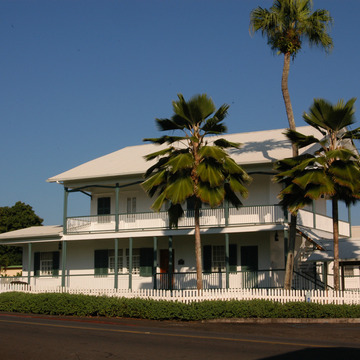The oldest frame building on the island of Hawaii, this two-story colonial-style house was built for David and Sarah Lyman, Congregationalist missionaries in Hilo. Upon their arrival in 1832, the couple lived in a thatched house. Seven years later, this structure was built, in part by Hawaiian students from the nearby Hilo Boarding School. A remodeling in 1855 added the second story and the corrugated-metal gable roof, much to the great appreciation of Sarah Lyman, who noted, “We got tired of living under a roof of thatch, which needed renewing every four or five years, and mending frequently.” Following the deaths of the Lymans in 1884 and 1885, the house was sold, and for a time utilized as a boardinghouse. In 1930, Emma Lyman Wilcox and her two daughters purchased the house, and in 1932, it was restored and converted into a museum, one of the earliest house museums in Hawaii. At that time, the house was turned ninety degrees on its axis and moved to its present location to accommodate the extension of Haili Street.
The Hilo Boarding School, which was located near the house, was founded by Reverend Lyman in 1836. Here farming and carpentry were taught, and the school gained a considerable reputation for the quality of its koa furniture. It later served as the model for vocational schools such as Hampton Institute in Virginia.


